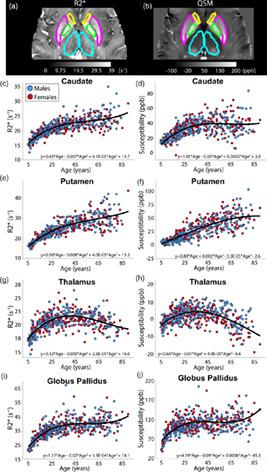当前位置:
X-MOL 学术
›
Hum. Brain Mapp.
›
论文详情
Our official English website, www.x-mol.net, welcomes your feedback! (Note: you will need to create a separate account there.)
R2* and quantitative susceptibility mapping in deep gray matter of 498 healthy controls from 5 to 90 years
Human Brain Mapping ( IF 4.8 ) Pub Date : 2021-06-29 , DOI: 10.1002/hbm.25569 Sarah Treit 1 , Nashwan Naji 1 , Peter Seres 1 , Julia Rickard 1 , Emily Stolz 1 , Alan H Wilman 1 , Christian Beaulieu 1
Human Brain Mapping ( IF 4.8 ) Pub Date : 2021-06-29 , DOI: 10.1002/hbm.25569 Sarah Treit 1 , Nashwan Naji 1 , Peter Seres 1 , Julia Rickard 1 , Emily Stolz 1 , Alan H Wilman 1 , Christian Beaulieu 1
Affiliation

|
Putative MRI markers of iron in deep gray matter have demonstrated age related changes during discrete periods of healthy childhood or adulthood, but few studies have included subjects across the lifespan. This study reports both transverse relaxation rate (R2*) and quantitative susceptibility mapping (QSM) of four primary deep gray matter regions (thalamus, putamen, caudate, and globus pallidus) in 498 healthy individuals aged 5–90 years. In the caudate, putamen, and globus pallidus, increases of QSM and R2* were steepest during childhood continuing gradually throughout adulthood, except caudate susceptibility which reached a plateau in the late 30s. The thalamus had a unique profile with steeper changes of R2* (reflecting additive effects of myelin and iron) than QSM during childhood, both reaching a plateau in the mid-30s to early 40s and decreasing thereafter. There were no hemispheric or sex differences for any region. Notably, both R2* and QSM values showed more inter-subject variability with increasing age from 5 to 90 years, potentially reflecting a common starting point in iron/myelination during childhood that diverges as a result of lifestyle and genetic factors that accumulate with age.
中文翻译:

498 名 5 至 90 岁健康对照者的深灰质 R2* 和定量易感性图谱
深灰质中铁的推定 MRI 标志物已证明在健康儿童期或成年期的不同时期发生了与年龄相关的变化,但很少有研究涵盖整个生命周期的受试者。本研究报告了 498 名 5-90 岁健康个体的四个主要深部灰质区域(丘脑、壳核、尾状核和苍白球)的横向弛豫率 (R2*) 和定量磁化率映射 (QSM)。在尾状核、壳核和苍白球中,QSM 和 R2* 的增加在儿童期最为剧烈,并在整个成年期逐渐持续,除了尾状核易感性在 30 年代后期达到平稳期。丘脑有一个独特的轮廓,R2*(反映髓磷脂和铁的加性效应)比儿童时期的 QSM 变化更陡峭,两者都在 30 年代中期到 40 年代初达到一个平台期,然后下降。任何地区都没有半球或性别差异。值得注意的是,随着年龄从 5 岁增加到 90 岁,R2* 和 QSM 值都显示出更多的受试者间变异性,这可能反映了儿童时期铁/髓鞘形成的共同起点,该起点因生活方式和随年龄积累的遗传因素而不同。
更新日期:2021-09-02
中文翻译:

498 名 5 至 90 岁健康对照者的深灰质 R2* 和定量易感性图谱
深灰质中铁的推定 MRI 标志物已证明在健康儿童期或成年期的不同时期发生了与年龄相关的变化,但很少有研究涵盖整个生命周期的受试者。本研究报告了 498 名 5-90 岁健康个体的四个主要深部灰质区域(丘脑、壳核、尾状核和苍白球)的横向弛豫率 (R2*) 和定量磁化率映射 (QSM)。在尾状核、壳核和苍白球中,QSM 和 R2* 的增加在儿童期最为剧烈,并在整个成年期逐渐持续,除了尾状核易感性在 30 年代后期达到平稳期。丘脑有一个独特的轮廓,R2*(反映髓磷脂和铁的加性效应)比儿童时期的 QSM 变化更陡峭,两者都在 30 年代中期到 40 年代初达到一个平台期,然后下降。任何地区都没有半球或性别差异。值得注意的是,随着年龄从 5 岁增加到 90 岁,R2* 和 QSM 值都显示出更多的受试者间变异性,这可能反映了儿童时期铁/髓鞘形成的共同起点,该起点因生活方式和随年龄积累的遗传因素而不同。



























 京公网安备 11010802027423号
京公网安备 11010802027423号